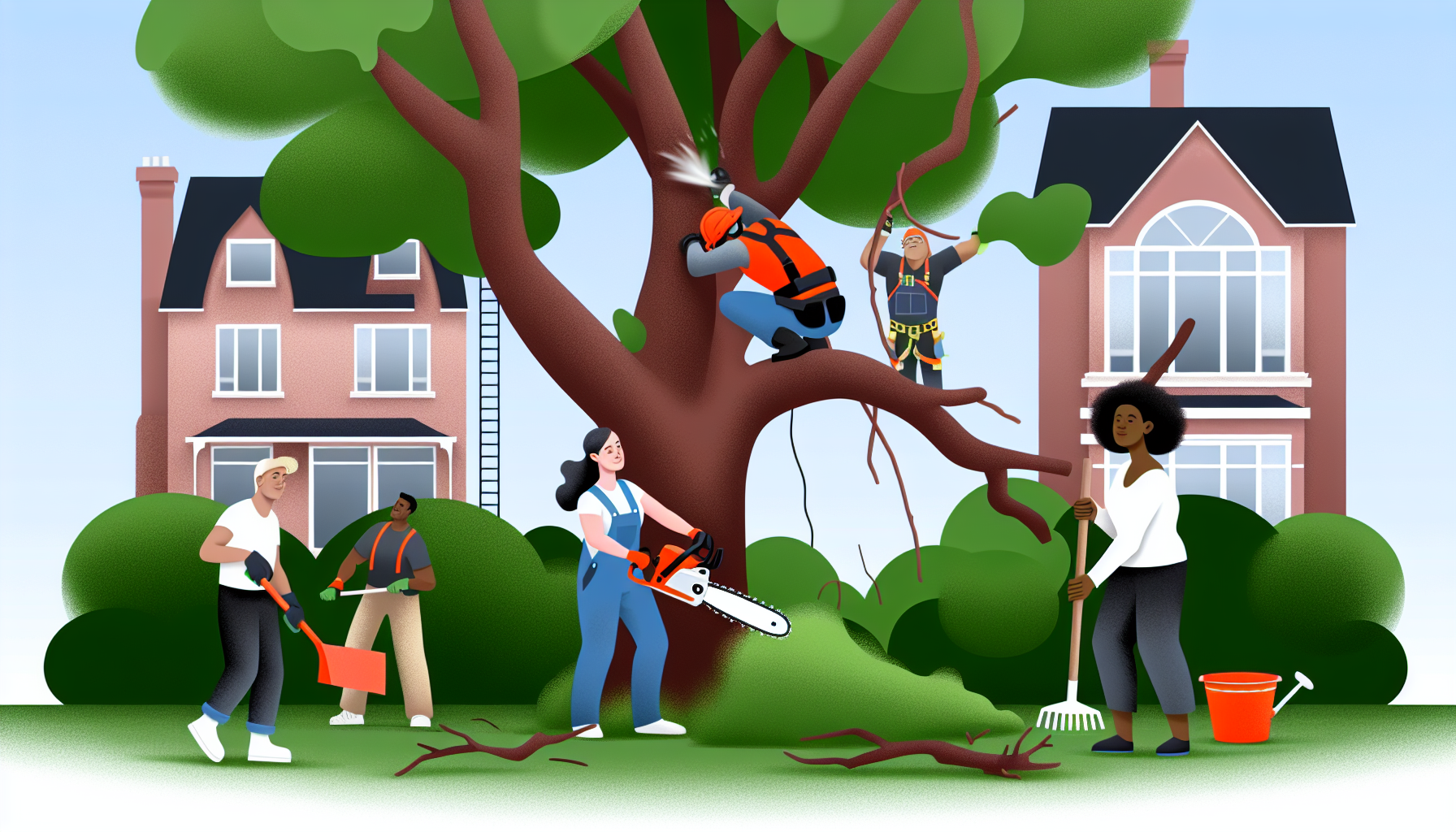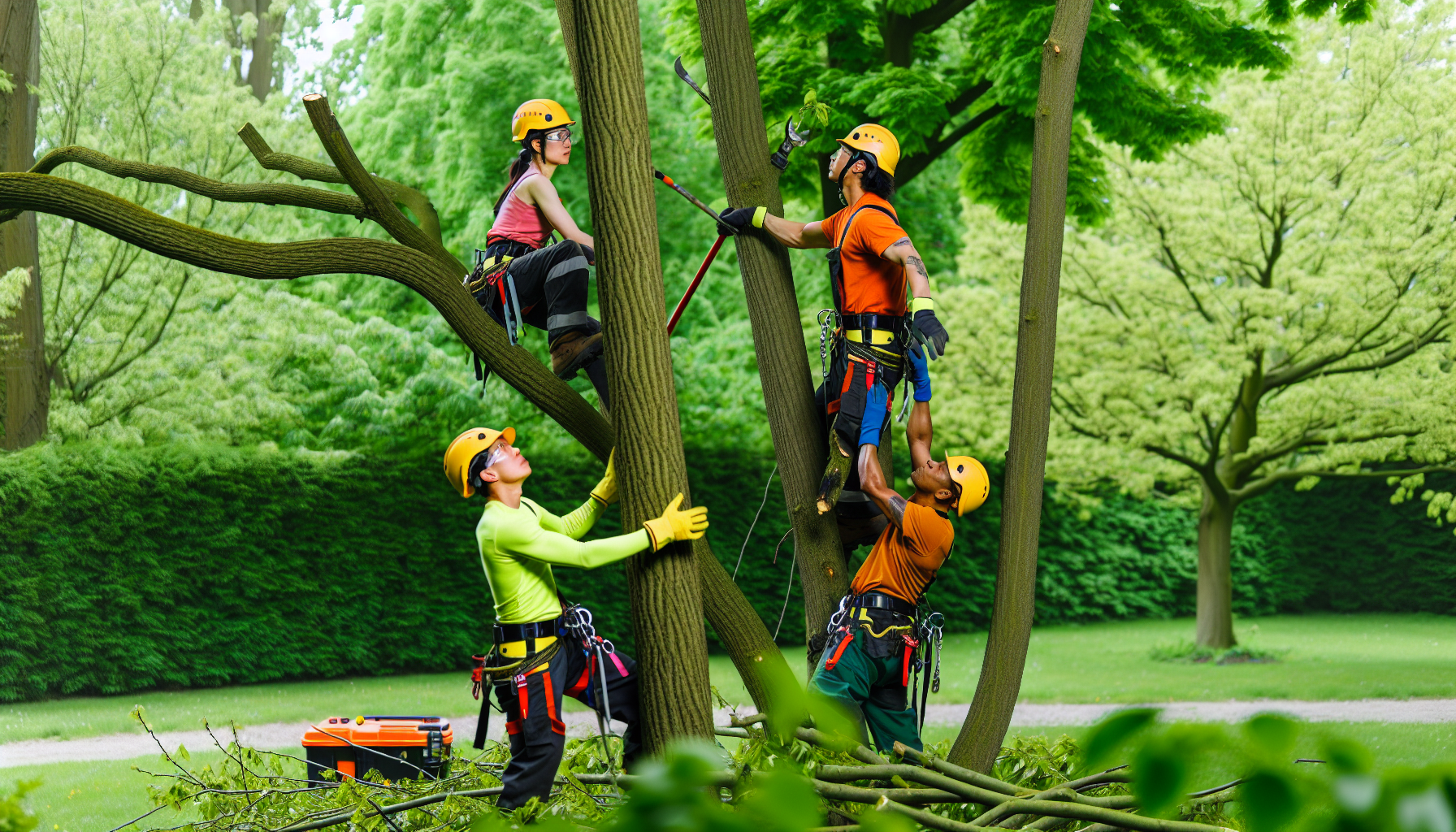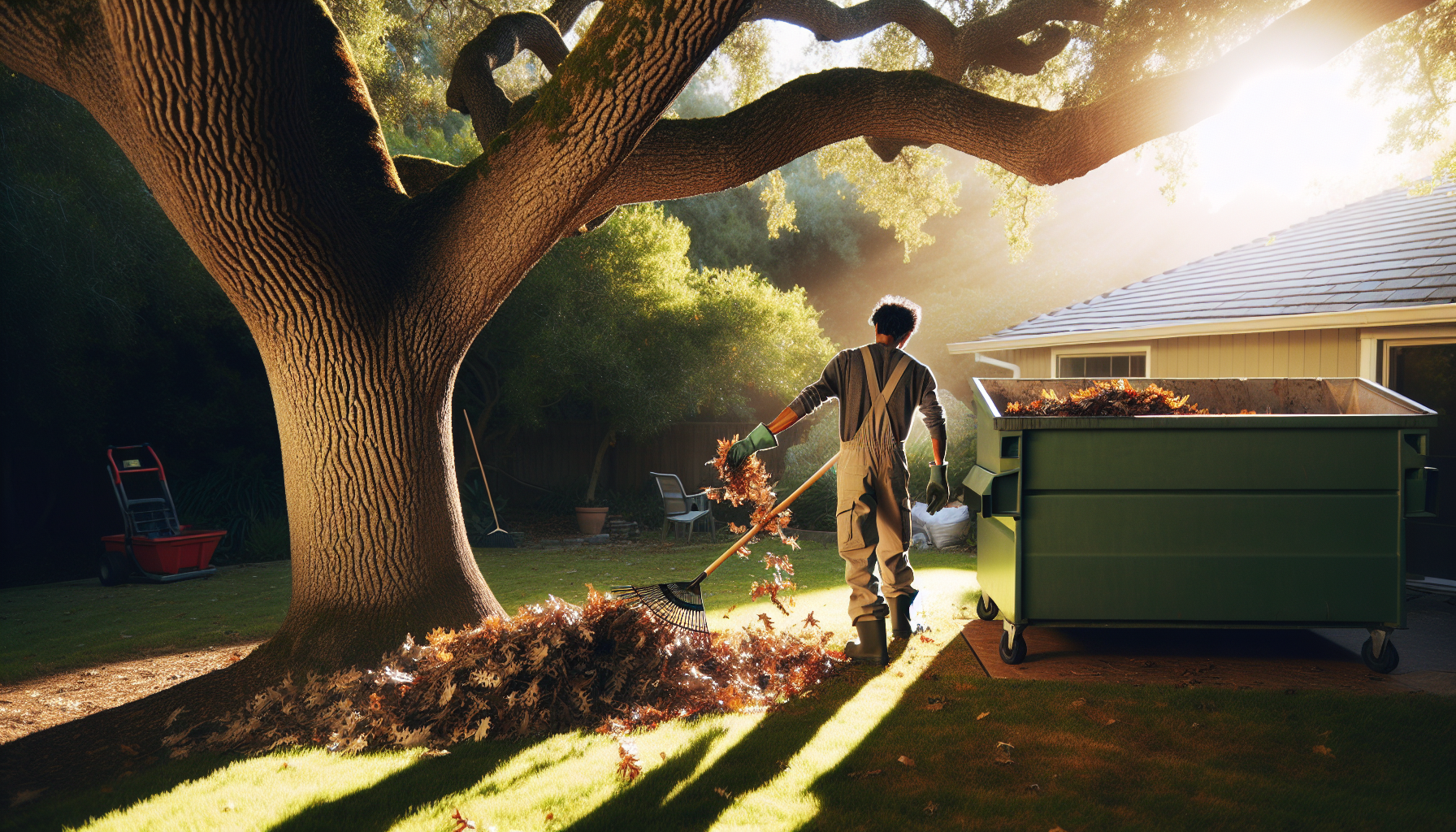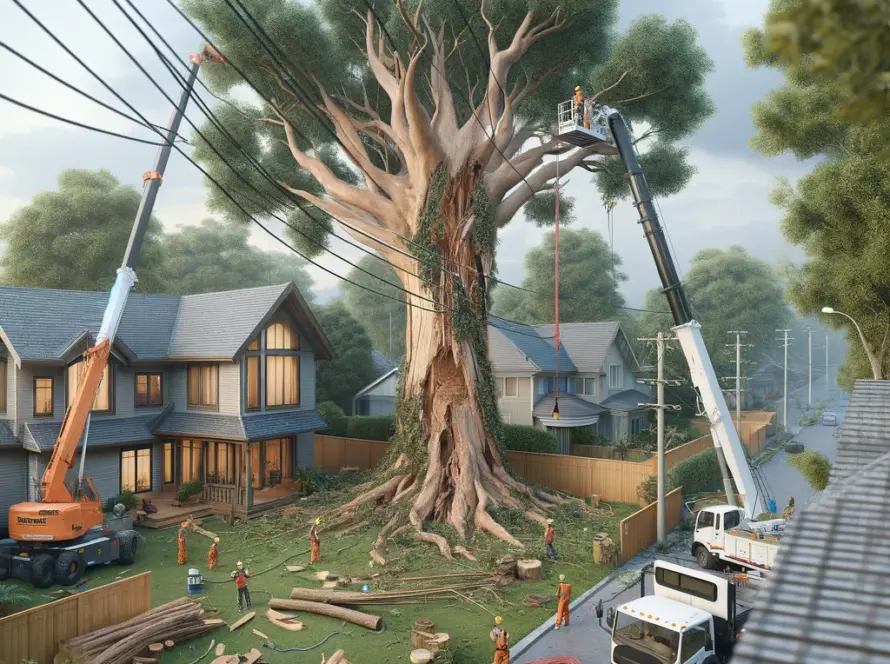Are you looking for the best, quickest ways to do tree branch removal?
- You may think it’s going to half a day just to clean your yard.
- Or that you will have to spend a ridiculous amount of money to get this done.
- But – there are a ton of easy, cost-effective ways to get tree branches removed if you’re a homeowner.
This guide will navigate you through the intricacies of tree branch removal, including cost factors, strategic removal tips, disposal options, and when to call in the professionals, ensuring you make informed and effective decisions for your yard.
Key Takeaways
Tree branch removal costs vary significantly based on the tree’s size, accessibility, condition, and the equipment needed, with average costs ranging from $315 to $700 for professional trimming.
Strategies for managing multiple branch removal costs include negotiating, contributing to the work, scheduling regular maintenance, and considering bulk removal for significant discounts.
Disposal of tree branch debris can be handled through several methods including traditional hauling services or eco-friendly options like composting, with costs influenced by the volume and type of debris.
- https://youtu.be/NYUGzsMq0qg?si=0n3PfPpxqd_iPWLS
Understanding Tree Branch Removal Costs

Understanding the costs associated with removing tree branches may seem like a daunting task. Being aware of the different factors that contribute to these expenses can help you make an informed decision. The average cost for professional branch removal ranges from $315 to $700, with most homeowners spending around $475. But this amount can vary significantly based on various aspects such as tree size and accessibility during the process.
Factors like location also play a significant role in determining branch removal costs. A tree in an easily accessible area will be less expensive to remove compared to one located in a hard-to-reach spot, which might require special equipment and extra effort for successful removal. Additionally, the condition of the tree is also important, dead trees are more hazardous and difficult to remove hence they typically incur higher expenses than live ones.
For small or medium-sized branches, prices usually include both cutting and disposal from site charges ranging between $75-$250 depending on variables including branch size and access difficulty.At times, bigger tasks like removing entire trees could attract even higher fees due to increased labor requirements, equipment usage, and related logistics.
Price Range for Small to Medium Branches
The cost of removing small to medium branches from trees is usually around $80 to $350, taking into account factors like the type of tree and its accessibility. Depending on the specific characteristics of each tree, there may be larger or more complicated limbs that require special considerations when determining pricing. If a fallen branch has made it difficult for workers to access the area safely, additional time and specialized equipment may also result in higher costs.
Typically, companies charge a flat fee for branch removal services instead of charging per individual branch or tree. This rate often includes any other yard waste that results from the job as well – whether it’s caused by storm damage or simply excess material generated during routine maintenance tasks such as trimming large trees. Regardless of why you’re dealing with multiple fallen branches in your yard at once, expect to pay according to how complex the overall task becomes rather than based on quantities alone.
Financial Implications for Large Limb Extraction
When it comes to removing large tree limbs, the costs can vary greatly. The price for this type of extraction typically falls between $150 and $850 due to factors such as equipment needed and project size. The health of the tree itself plays a role in determining cost along with other aspects like complexity of work and location.
The specific characteristics of different types of trees can also impact pricing for limb removal services. Some species are easier to remove than others, which may result in variations in overall cost. If the tree is difficult to access or requires specialized machinery, expenses may be even higher.
To perform a task like extracting large limbs from trees usually involves renting a bucket truck at an average rate of around $160 per day. Final rental fees will depend on various details including duration rented and vehicle size utilized during service.
Strategizing Multiple Branch Removal

Careful planning is essential when dealing with multiple tree branches. The average cost of removing them can range from $750 per tree to an hourly rate between $50 and $125 for professional trimmers. By taking the time to plan ahead and tackling larger branch removals independently, significant savings can be made. There may also be opportunities to negotiate a better deal or receive discounts from tree removal companies if you are removing several branches at once.
There are various effective strategies that can help reduce the expense of removing multiple tree branches.
Negotiating costs
Contributing towards some of the work such as clearing debris
Scheduling regular maintenance appointments to prevent costly emergency removals
By being willing to get involved in physically helping out with tasks like debris clearance, it could potentially result in considerable financial savings.
In order to save money on handling numerous trees sections, carefully organized steps should first be taken before execution plans commence – this is critical. On usual circumstances cutting off individual areas takes around 60 minutes, which prices stand at either an expensive-rate e.g., fifty bucks up to hundred twenty-five dollars whereas more extensive action done separately qualifies trimming closely significantly cheaper). Consolidating these jobs autonomously early helps accumulative cuts superlatively decreasing fees especially allowing additional budget bonuses provided by removers even though picking over bundles all-at-once fully.
Bulk Removal Savings
Bulk tree branch removal is a cost-effective option, particularly for dealing with multiple trees or extensive projects. The potential savings from this approach can range between $150 to $6,000 per acre depending on factors such as the number and size of the trees involved. In fact, many companies offer discounts up to 20-30% for larger branch removal jobs.
On average, the cost for removing branches in multi-tree projects is around $255, but may vary between $129 and 460$. This estimate depends heavily on certain variables like tree type and size, location accessibility, condition of the tree itself along with equipment required and risk level associated.
The price tag typically increases when it comes to large-scale cleanups due primarily because they require more advanced machinery which also poses higher risks during execution. To optimize your spending while getting rid of several unwanted limbs at once, you might want to optimize your spending.
Debris Disposal Options

Once you have cleared the tree branches, it’s important to consider how you will dispose of all the debris. You have a few options available, such as traditional methods like hauling or more environmentally-friendly alternatives like composting and recycling. You could choose to rent a dumpster or use your local yard waste collection services. Another option is hiring a junk removal service or taking the materials directly to a nearby recycling center.
There are also several ways to properly dispose of tree branches and other yard waste while being mindful of our environment. One approach is utilizing these materials as mulch in your garden, which has various benefits including reducing waste, enriching soil with nutrients, and capturing carbon dioxide from the air through decomposition. Other eco-friendly choices include composting them on-site or exploring community disposal programs that prioritize sustainable practices.
Remember that no matter how you decide to handle your yard waste after pruning trees and clearing out debris, it’s crucial always do so responsibly for both practical purposes and environmental concerns, whether this means simply getting rid of everything efficiently by haulage methods versus opting for greener solutions using organic matter only!
Hauling Away Yard Waste
When hiring a tree service professional, the removal of yard waste is typically included in their overall fee. The cost for this service depends on the amount and size of debris that needs to be hauled away. Usually, it ranges from $150 to $350 for removing and disposing half a truckload’s worth of yard debris.
Different types of waste may require specific disposal methods which can also affect the price. Factors such as weight and volume should be taken into account when considering hauling as an option for removing yard waste. It is important to carefully consider all these elements before making a decision in order to find the most economical choice available.
Eco-Friendly Disposal Alternatives
When it comes to eco-friendly disposal methods for tree branches, there are several options available. Renting a dumpster is a convenient and sustainable choice that saves time and resources while providing predictable pricing. The total cost can vary between $25 to $200 for disposal fees, along with an additional fee of $150 to 350$ depending on the size of the dumpster, location, and type of material being disposed.
Curbside waste/recycling services also offer an environmentally friendly solution for disposing of yard waste such as tree branches. However, they usually require the branches to be cut into smaller pieces and tied in bundles before pickup can occur. Another way you can dispose sustainably is by reusing your tree’s debris as mulch in garden beds or putting them out alongside other yard waste meant specifically for collection purposes.
Whether choosing rental dumpsters or using curbside services, these eco-conscious alternatives provide practical solutions for getting rid of unwanted trees’ branches without causing harm unnecessarily.
Key Factors Influencing Branch Removal Pricing
The cost of branch removal is influenced by various factors, such as the type and condition of a tree, which can result in an inspection fee ranging from $150 to $550. The size of branches also plays a significant role, with larger trees and their accompanying bigger branches requiring more resources and effort for removal.
Apart from that, other considerations include the number of branches present on a tree and its accessibility. More labor-intensive tasks involving numerous large branches may incur higher costs while easier access to the tree would typically lead to lower expenses. If the location poses challenges in reaching or removing the desired branch, it could require specialized equipment along with additional time and manpower resulting in increased pricing for this service.
The Right Questions to Ask Your Tree Service Provider
When it comes to removing branches from trees, it is essential to ask relevant questions of your chosen tree service provider. It is crucial that they have the appropriate insurance coverage, such as general liability insurance, business owner’s policy, commercial auto insurance and workers’ compensation for complete protection. You can confirm a company’s license by requesting a copy of their certificate of insurance from the insurer or checking with local authorities.
Another critical aspect to consider is how they prune trees. Avoid companies that use harmful pruning techniques like excessive trimming, topping off branches at an incorrect angle or time frame when trees are under stress. They should also not engage in improper cutting practices without clear objectives and avoid using wound dressings or creating “lion tails” on trimmed branches.
It is important always remember never ever attempt any kind of branch removal yourself, instead call only professional experts because there are risks involved.Trees will grow stronger, but after you remove heavy ends, be sure to feed them!
Ensuring Safe and Efficient Practices
Ensuring the safety and efficiency of your tree service provider is crucial for a successful project. Professionals utilize various important tools like chainsaws, wedges, wood chippers, climbing equipment, ladders, helmets and protective gear to safely remove branches from trees or after dealing with fallen ones.
To ensure that a tree service company follows proper regulations and standards for safety measures, check if they are bonded. This indicates their commitment to adhering to strict industry protocols regarding equipment usage and safe practices. It’s also essential that they follow standard operating procedures such as obtaining permits when required, creating a secure work area free from underbrush/limbs, managing traffic around the work site.
Innovative Ways to Repurpose Tree Limbs and Stumps

After the safe removal of tree branches, you may be left wondering about the disposal of the remaining limbs and stumps. The good news is, there are several innovative ways to repurpose them, such as:
Crafting unique furniture pieces
Using them to enhance your garden
Turning them into firewood
Creating natural sculptures or art pieces
Using them as natural borders or edging in your landscaping
The possibilities are endless!
Stumps can also serve valuable wildlife habitats, offering animals perching spots and a source of food as they decompose. This not only helps to enrich the local ecosystem, but also provides a unique opportunity to observe local wildlife up close.
From Branch to Bench: Crafting Furniture
Repurposing tree limbs and stumps into unique furniture pieces is a great way to add a personal touch and rustic feel to your home. You can create different types of furniture like chairs, tables, benches, or custom-made items by utilizing these natural elements with the help of various tools such as hammers, routers, sleds and specialized chairmaking equipment.
The process of making furniture from tree limbs involves first drying them out completely before removing their bark. Straight branches are then used for creating table legs or other decorative features in garden benches made from wood. Several online tutorials provide step-by-step instructions on how you can try this DIY project at home.
While crafting wooden furniture using trees, it’s important to prioritize safety measures.Precautionary gear should be worn, such as hard hats, sturdy boots, gloves, and hearing protection.If storing trunks for drying purposes, prior arrangements must be made beforehand, to avoid any unfortunate incidents that might occur due to lack of proper storage methods.
Enhancing Your Garden with Natural Elements
Incorporating natural elements like tree branches, logs, and stumps can greatly benefit your garden. Instead of disposing them, you can repurpose these items into functional or decorative pieces. For instance, turning tree stumps into furniture such as stools or chairs adds a unique touch to the garden while using them as bases for fairy gardens or bird sanctuaries brings in an element of whimsy.
Tree branches also have various uses in gardening. They not only provide support but also add aesthetic value when incorporated within the structure of a garden. By inserting them directly into the soil, they serve as natural trellises or plant supports. Alternatively, stacking creatively stacked up creates visually appealing structures that enhance any green space. In case a tree falls down due to unforeseen circumstances, its branches can still be utilized for similar purposes.
By harnessing nature’s resources through trees and their fallen parts specifically mentioned above, there is much potential for enhancing your outdoor space with minimal cost involved! Embrace this idea today to elevate your personal oasis even further!
The Eco-Conscious Approach to Tree Management
Our company stands out for our environmentally-friendly approach to managing trees. Whenever we cut down a tree, we take the following actions:
We plant a new tree in nature to offset any negative impact on the environment.
Trees naturally absorb carbon dioxide and store it in their trunks, branches, roots, and leaves. This helps mitigate environmental damage caused by cutting down trees.
Our efforts also contribute to cleaning the air and reducing greenhouse gas emissions.
We are dedicated to sustainability and being responsible stewards of the environment through our commitment to planting more trees.
Replanting forests offers numerous benefits including:
Restoring natural ecosystems
Preserving biodiversity
Maintaining soil fertility
Improving air quality.
Providing habitats for wildlife.
Protecting endangered species.
Additionally,replanting can help protect watersheds from pollution while also lowering potential risks of natural disasters such as floods or landslides. Furthermore, replenishing forest areas has been proven beneficial in maintaining overall health within these environments.
Therefore,every time we remove a tree due, it is not just about taking one away, but actively giving back precious resources that will benefit both humans,nature,and animals alike.
When DIY Isn’t Enough: Recognizing the Need for Professional Help
While the thought of doing tree branch removal on your own may seem attractive, there are circumstances that require professional assistance. This includes situations where the tree is dead, dying or poses a threat to people and property. After severe storms, it’s best to call in professionals who have expertise in safely dealing with broken limbs and branches.
Safety is paramount during branch removal, which is why professionals use proper harnesses and take measures to maintain stability of the trees they work on. They also ensure safe distances from potential hazards such as power lines by managing them appropriately. While DIY attempts can be satisfying, they may not always guarantee safety or efficiency when compared to seeking help from experienced professionals.
Navigating Yard Waste Pickup and Collection Services
Managing large amounts of yard waste can be a daunting task. Our team is available to assist you through various methods such as text, email, phone calls or zoom for your convenience. Our efficient customer service will always be there to offer support.
Requesting yard waste pickup and collection services can either be done by contacting the specific company directly or using their online platform to schedule a pick-up date. The costs may vary between $40-$700 depending on factors like disposal method used, weight/volume of waste and location. Whether it’s just branches or an entire tree that needs removal from your yard, we have everything covered.
You don’t need to stress about managing all that extra debris in your backyard anymore! We are here with affordable solutions for every type of yard situation – big piles/bags full, so you never have any issues dealing with excess foliage again.
Preparing for Tree Branch Removal

Before removing a tree branch, it is important to be aware of the costs involved and available disposal options. In some cases, professional assistance may also be necessary. Homeowners can estimate the average cost for this type of service by taking into consideration that on average, tree branch removal ranges from $385 to $1,070 or approximately $10 to $14 per foot.
To prepare for the removal process itself, homeowners should assess the condition of their tree branches and plan accordingly by creating designated staging areas. Protecting nearby surroundings as well as informing neighbors about upcoming work are also crucial steps in ensuring safety during removal. Clearing access routes for vehicles and relocating any fragile objects will help facilitate a smooth operation while clarifying specific requirements with professionals ensures an efficient outcome overall.
Summary
Managing tree branches involves more than just cutting them down. It requires careful consideration of expenses, devising a strategy for removing multiple branches, selecting the best disposal methods, asking your chosen tree service provider relevant questions and knowing when to seek professional assistance. By properly planning ahead and keeping in mind our impact on the environment, we can effectively care for our trees while also benefiting both ourselves and nature.
Frequently Asked Questions
How much does it cost to remove a branch from a tree?
Removing a branch from a tree can cost between $200 and $300 per hour for a tree removal company.
How do you get rid of bunch of tree branches?
When faced with the task of getting rid of a large quantity of tree branches, there are several options available. These include renting a dumpster or wood chipper to dispose of them, hiring someone to haul them away, taking them to a landfill yourself, and using a wood chipper to create compost.
Alternatively, you could also consider storing some for firewood or repurposing the branches in building an animal habitat. This way they can serve as both functional materials and contribute positively towards environmental sustainability by reducing waste.
What is it called to remove branches from a tree?
Cutting off branches from a tree can be referred to as lopping and topping. Lopping includes taking out sizable lateral branches with vertical cuts, while topping entails removing a significant portion of the uppermost part of the tree through horizontal cuts.
How can I save on multiple branch removal?
To save on multiple branch removal, plan in advance and execute larger branch removals independently to achieve substantial savings.
How does professional tree branch removal ensure safety?
Ensuring the safety of tree branch removal is crucial, and can be achieved through proper use of harnesses, maintenance of tree stability, safe distances being observed at all times, and careful management of nearby power lines. This approach guarantees a secure and effective process for removing branches from trees.




